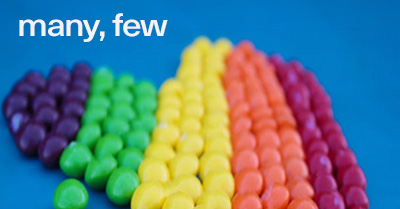Less and Fewer (Advanced, C-Level)
Email this page
You may have seen the sign for the express lane at the grocery store that says “15 items or less.” Many people get angry about it because, according to them, it should say “15 items or fewer.” What’s going on?
In this lesson and video, learn what you should use in standard grammar
Comparatives and Superlatives
Much and Many
Much and many are used with count and non-count nouns, respectively. For example, you say much time (non-count) but many hours (countable).
The comparative and superlative forms of much and many are
much - more - the most
many - more - the most

Andrew Neel | Pexels
Little and Few
(A) little and (a) few are also used with count and non-count nouns. For example, you say little time but a few hours.
Their comparative and superlative forms are
little - less - the least
few - fewer - the fewest

Sidney Troxell | Pexels
What’s the Problem?
There was a time when less and the least were also used as the comparative and superlative forms of few. For whatever reason, some grammarians decided that, because fewer and fewest also existed, it would be preferable to use fewer and fewest to keep the table “neat” (i.e., without alternate forms for few).
People took this suggestion as a steadfast rule. Now, there are many who balk at using “less” for countable nouns as in “15 items or less.” Even though “15 items or fewer” sounds odd to most speakers, grammar sticklers insist that is the only grammatically acceptable form.
The Bottom Line
To be safe, whenever you are using “fewer” or “less” in a formal situation such as writing a business letter or an academic essay, choose fewer for count nouns and less for non-count nouns.
Attention!
Saying a noun is “countable” or “non-countable” sometimes causes confusion. For example, you may think, “I can count money, so money is countable.” That is not quite correct.
Words have multiple meanings. When you talk about what you use to buy things, you use “money” as an uncountable noun. You say, “I don’t have much money on me,” not “monies.” When you count money, you count dollars, rupees, euros, and so on. “Money” is an uncountable noun” whereas “dollars,” “rupees,” and “euros" are countable nouns.
If you see “moneys” (or “monies”) being used, it means something else such as types of currencies (e.g., “His company deals with moneys from different countries”) or distinct sums of money or funds in legal or financial language (e.g., “The researcher applied for monies from different sources.").
This happens with many other words. For example, “water” is an uncountable word in its general sense (e.g, “You should drink a lot of water”). “Waters” refers to types or bodies of water such as oceans, lakes, or rivers (e.g., “The waters off the coast of California are quite cold").
You can also make some uncountable nouns plural to refer to how they are measured. For example, you drink a great deal of “coffee” (uncountable). When people order “two waters” or “three coffees” at a coffee shop, they are ordering “two (bottles) of water” or “three (cups) of coffee.”
Practice
Practice 1. Fill in the blanks using less, least, fewer, or fewest.
Congratulations on completing this lesson!

Thanks to our supporters!
This material has been made possible by supporters like you. Learn how you can support us.

“What should I learn next?”
Use the navigation buttons to choose another skill or another lesson in this skill.
Thank you for Supporting Snap Language
Snap Language supporters make the creation of these materials possible.
Learn how you can support our work, get perks, and help us continue creating high-quality materials.
You can support us by simply white-listing this site.